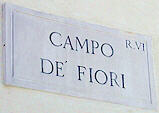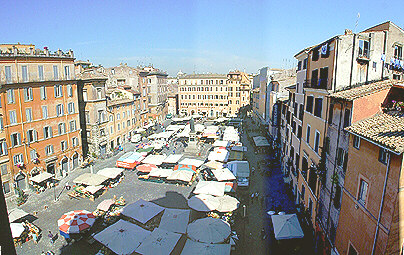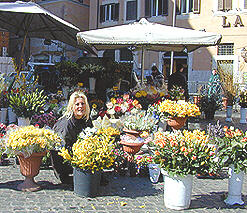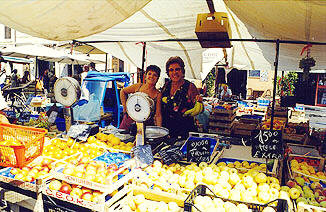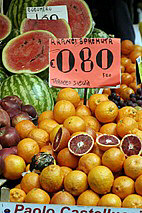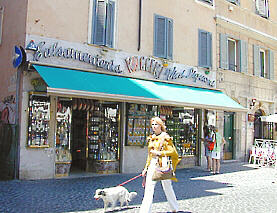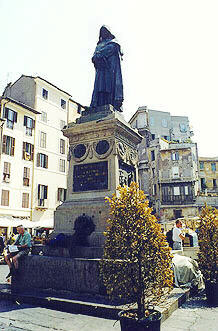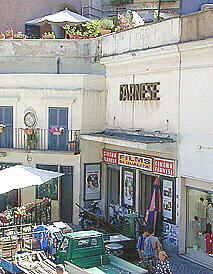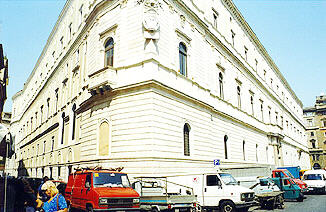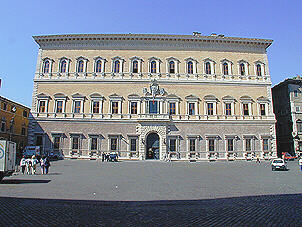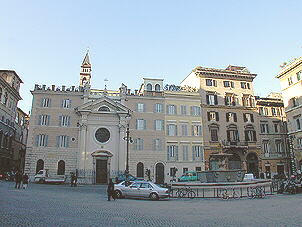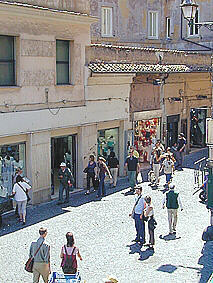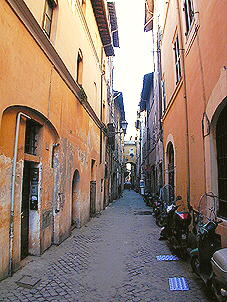
Visit also the page about the surrounding areas: Via Giulia, Largo Argentina, Via del Corso
Piazza Campo de' Fiori owes its name to the "field of flowers" (the apostrophized de' instead of the Italian dei is typical of the Romanesque dialect) which existed before the current palazzi were built in the 15th century. It is very near Piazza Navona. The palazzi encircle a very large square with inns, shops, and the famous colourful market still held every morning except Sunday, although currently its activity is being partly restrained. The square is the centre of a quarter with many facets. |
"THE TURTLES' DREAM": wonderful four bedroom three bathrooms, amazing sitting room, separate large dining room / kitchen, terrace in historical palace facing the Turtle Fountain. Elevator. New! Highly recommended (up to 8 guests). "The TURTLES NEST": Finest four bedroom three bathroom apartment with sitting room, dining room, panoramic terrace / roof garden with stunning Rome views, BBQ and additional kitchen, in an elegant historical palace facing the famous Tortoise fountain. Excellent fittings and equipment. Elevator! (up to 8 guests). "SIGNORA TOWN HOUSE WITH TERRACE ": Finest two bedroom town house, with sitting room-dining room, large terrace, kitchen, in an elegant historical palace near Piazza Navona and the antiquary street Via Coronari. Excellent fittings and equipment. "CARAVAGGIO", an elegant designer one bedroom apartment, tastefully and skillfully prepared and remarkably equipped (up to 3 guests). "MARCO POLO", a two double bedroom, sitting room attic with large terrace and spectacular views of all Rome (4 guests). Elevator. "ROMAN ROOFS": a one bedroom top floor apt. with ample sitting-dining room, patio and panoramic terrace overlooking old Rome's roofs and sights (up to 4 guests). "ROME PANORAMA": Large elegant designer panoramic attic near Piazza Navona, with 4 bedrooms (5 in summer) and 4 bathrooms. Two expansive panoramic terraces with 360 degree views of all Rome's sites. Elevator. Sitting room, separate dining room, fireplace. Unobtainable! (up to 7 guests). BRING YOUR BINOCULARS! "ROME DOMES": Fine 2 bedrooms 2 bathroom attic, with sitting room, dining room, large open plan kitchen, with 2 utmost panoramic terraces with views of Rome's domes, in an elegant historical palace facing the famous Tortoise fountain. Daily cleaning (4-5 guests). Elevator. "TORTOISES": Finest 3 bedroom 3 bathroom apartment with sitting room, dining room, large terrace with views, in an elegant historical palace facing the famous Tortoise fountain. Excellent fittings and equipment. Daily cleaning. (3-6 guests). Elevator. |
|
At night tourists and Romans attend the many good pizzerie, restaurants, bars and cafes, rekindling the unique Roman atmosphere of history, art, love for life. Despite the important monuments around the square, the highlight is still the world-acclaimed picturesque veg market. You will discover, as the early English writers did (Shelley, Keats, Byron etc.) that roaming about it is a pleasant and inspiring experience. If you are friendly with the peddlers they will pamper you. In addition to the stalls, the large square is encircled by grocery stores, cafes, bars, restaurants, pizzerias, and pubs. |
|
|
|
A friendly peddler proudly shows her products |
The vivacious colours of the market |
A large grocery store |
However, and quite surprisingly, despite its poetic name and the amiable lively look, the square was in the past a site of assassinations. Julius Caesar was murdered in a subsidiary building of the Roman senate near the square (not in the Roman Forum!).
The square includes also important palaces and sights. Nearby, on the way to Piazza Navona, you find the elegant and majestic Palazzo della Cancelleria (below). Built at the end of the 15th century for Cardinal Riario, it is attributed to Bramante.
The granite columns of the courtyard came from the original church of San Lorenzo in Damaso (4th century), whose remains are beneath the palazzo. In turn, beneath the ruins of the church excavations have found remains of the ancient Roman Foro Boario, an overlapping of monuments typical of Rome.
Today the palace is the seat of the French Embassy and of the magnificent library of the Ecole Francaise de Rome, a research institute for historians and archeologists, mainly with Italian books. In the interior, there are magnificent frescoes, by Francesco Salviati, Taddeo Zuccari, and especially by the brothers Annibale and Agostino Caracci.
The area was also a reference to visitors. The Spaniards had their national church in Via di Monserrato, the English had the Venerable English college. The Bolognese, the Sienese, the Neapolitans (Spirito Santo dei Napoletani), and the Florentines all had churches in Via Giulia.
There were hotels for visitors, print shops and bookshops, and
crafts of all kinds, still extant. The names of the little winding
streets are very characteristic, revealing the underlying social
background. Via dei Cappellari is hence the "Hatters' Street", Via del
Pellegrino is the "Pilgrim's Street" (as it funnelled pilgrims from Capitol
Hill to the Vatican), Via dei Giubbonari is the "Uniform makers' Street",
Via dei Baullari is the "Trunk makers' Street", Via dei Chiavari is the "Locksmiths'
Street" etc. Bookshops can still be found in the Via del Pellegrino, trunks
are still made in Via dei Baullari, Via dei Giubbonari has many
clothes shops and tailors.
Visit Rome | Rome panoramic views | Rome apartments and villas | Inquire | Rome travel guide | Rome map | Service | Resources Roman Homes homepage |
